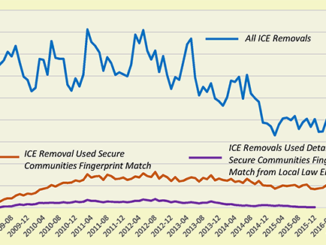
Between 2012 and 2018, immigrants contributed an average of $165.52 more per capita annually to the Medicare Trust Fund than Medicare spent on their behalf.
by Adriana Belmonte
Despite rhetoric that immigrants are a drain on taxpayers, new research indicates that immigrants have actually been helping to pay for health care for all Americans.
Two reports from the New American Economy, a bipartisan immigration research and advocacy organization, analyzed the amounts that immigrants — that is, residents and citizens who were born outside of the U.S. — paid into Medicare and private insurance premiums.
The researchers found that between 1996 and 2011, immigrants contributed $182.4 billion more to the Medicare Trust Fund than what the Fund spent on their health care. And between 2008 and 2014, immigrants contributed $174.4 billion more in health insurance premiums than was spent on them.
“Both of these briefs really counter assumptions and arguments often made or concerns that are raised that immigrants drain U.S. health resources,” Lynsie Ranker, an epidemiologist at the Institute for Community Health and one of the co-authors of the report, told Yahoo Finance. “This emphasizes the important contributions that immigrants make. In the case of private insurance, we’re talking about premium contributions. And in Medicare, we’re talking about the payroll taxes they contribute as working folks.”
And while immigrants require more government assistance than native-born Americans in some areas, the New American Economy research on Medicare and health insurance premium contributions further indicates that immigrants are less of a drain of taxpayer resources than many Americans believe.
The Cato Institute, a right-leaning libertarian think tank, found that the average immigrant as of 2018 “consumed $56 less in [Supplemental Security Income], $610 less in Medicare, and $1,808 less in Social Security retirement benefits than the average native in 2016 — more than compensating for their overconsumption of cash assistance, SNAP, and Medicaid.”
‘You can think of immigrants as subsidizing some of the costs’
Medicare, a publicly funded health insurance program for roughly 60 million Americans, is mainly funded by the Hospital Trust Fund, which is generated by payroll taxes.
The findings came as a result of the National American Economy multiplying wage and salary earnings by 2.9% — the rate of payroll taxes that fund Medicare — and adding in taxes from some Social Security income.
The program is mostly for people aged 65 or older, and most immigrants are on the younger side, which is part of the reason why they don’t cost the program as much as U.S.-born people.
“For Medicare, it’s really interesting because it has a lot to do with demographic trends and health trends,” Andrew Lim, director of quantitative research at the New American Economy and a co-author of the briefs, told Yahoo Finance. “In general, immigrants tend to be more working age and less likely to be elderly, who are more likely to be using Medicare. You have more immigrants who are still in the prime of their working ages, and obviously then through their payroll taxes, they’re contributing to the Medicare Trust Fund and they’re less elderly immigrants who are eligible to take out.”
Additionally, he noted, Medicare is also something that’s restricted to people who qualify either as citizens or qualified green card holders who are not yet citizens.
Between 2012 and 2018, the research noted, “immigrants contributed an average of $165.52 more per capita annually to the Medicare Trust Fund than Medicare spent on their behalf. Over the same time period, the U.S.-born cost the Trust Fund an average of $51.46 per capita, as more was spent on their behalf than was contributed.”
And in that same time span, immigrants paid $51 billion more in Medicare-related taxes than they used in Medicare-paid services. Within that group, non-citizen immigrants contributed even more at $75 billion than was spent on them. Concurrently, U.S.-born persons used $98 billion more than they contributed for the same taxes.
“In that respect, you can think of immigrants as subsidizing some of the costs or expenditures that are going out and going out disproportionately to U.S.-born people,” Lim said.
Additionally, the researchers theorize that the contributions from immigrants have been able to delay Medicare’s insolvency, though that could still happen as soon as 2024.
“In light of current predictions about the impact of the COVID-19 pandemic on the solvency of the trust fund, these subsidies are likely to be even more critical in the future,” they wrote. “Recent efforts to reduce the flow of immigrants is likely to threaten the solvency of the HITF and jeopardize healthcare for the 60 million Americans who rely on it. These findings suggest that efforts to stabilize the program’s finances should include immigration reform efforts that encourage the flow of immigrant workers into the United States.”
‘It really matters what happens … to immigration in the future’
It’s a similar story in terms of private insurance.
The National American Economy calculated this by factoring in the 2012-2018 Medical Expenditure Panel Surveys from the Agency for Healthcare Research and Quality and the 2013-2019 Current Population Survey from the U.S. Census Bureau and Bureau of Labor Statistics.
Each immigrant with private insurance between 2012 and 2018 contributed an average of $1,182 more in premiums than their insurer spent on them. Meanwhile, U.S.-born persons saw an average deficit of $155 per capita.
Ranker reiterated that the average age of immigrants plays a significant role in this, but that there are also other factors at play.
“We also need to think about barriers to accessing care in terms of issues around language-based services for people in which English isn’t their first language,” she said. “That might keep people from seeking care as well. But I think in terms of private insurance, what’s really driving the low expenditures among immigrants is their lower average age compared to U.S.-born persons.”
Health status is another contributor — according to Lim, immigrants tend to have lower levels of chronic conditions like obesity and diabetes, which can cause health care costs to build up significantly, especially as one ages.
“Given what we know about immigrants … and if things stay the same – you would imagine that the trends would stay the same – it really matters what happens in terms of health care policy in the future, but also what happens to immigration in the future,” Lim said. “If, for example, the United States was to suddenly restrict immigration, the immigrants we have today would just get older, but there would be no other immigrants to replenish them or stay in the workforce.”
Eventually, he continued, “you would see these numbers change because you can’t make more immigrants if you don’t let them come in. You can just make more people by having them being born here. That’s the thing that’s kind of the big question mark.”
Adriana Belmonte is the Senior Editor covering politics and health care policy for Yahoo Finance. You can follow her on Twitter @adrianambells and reach her at [email protected].



